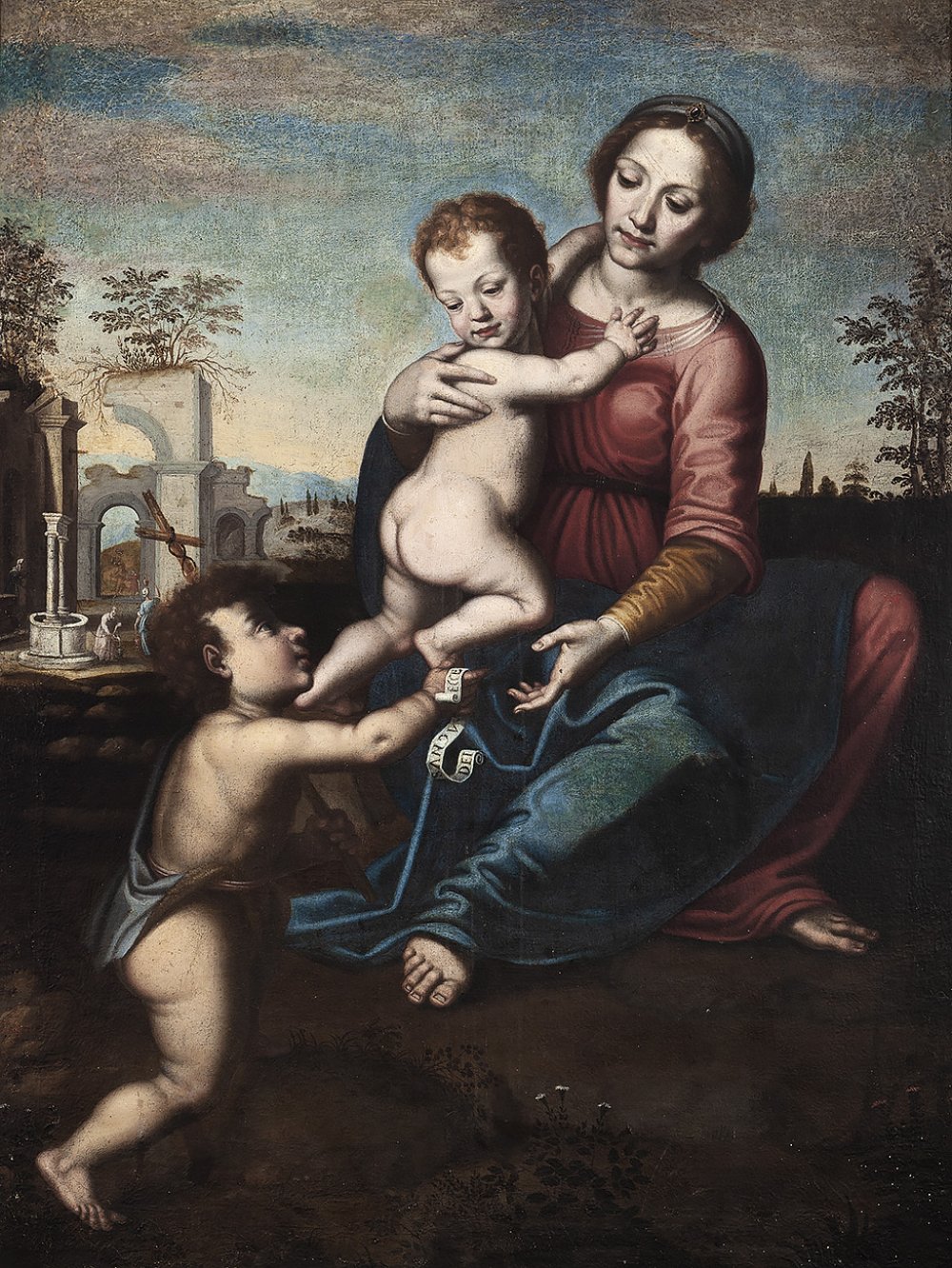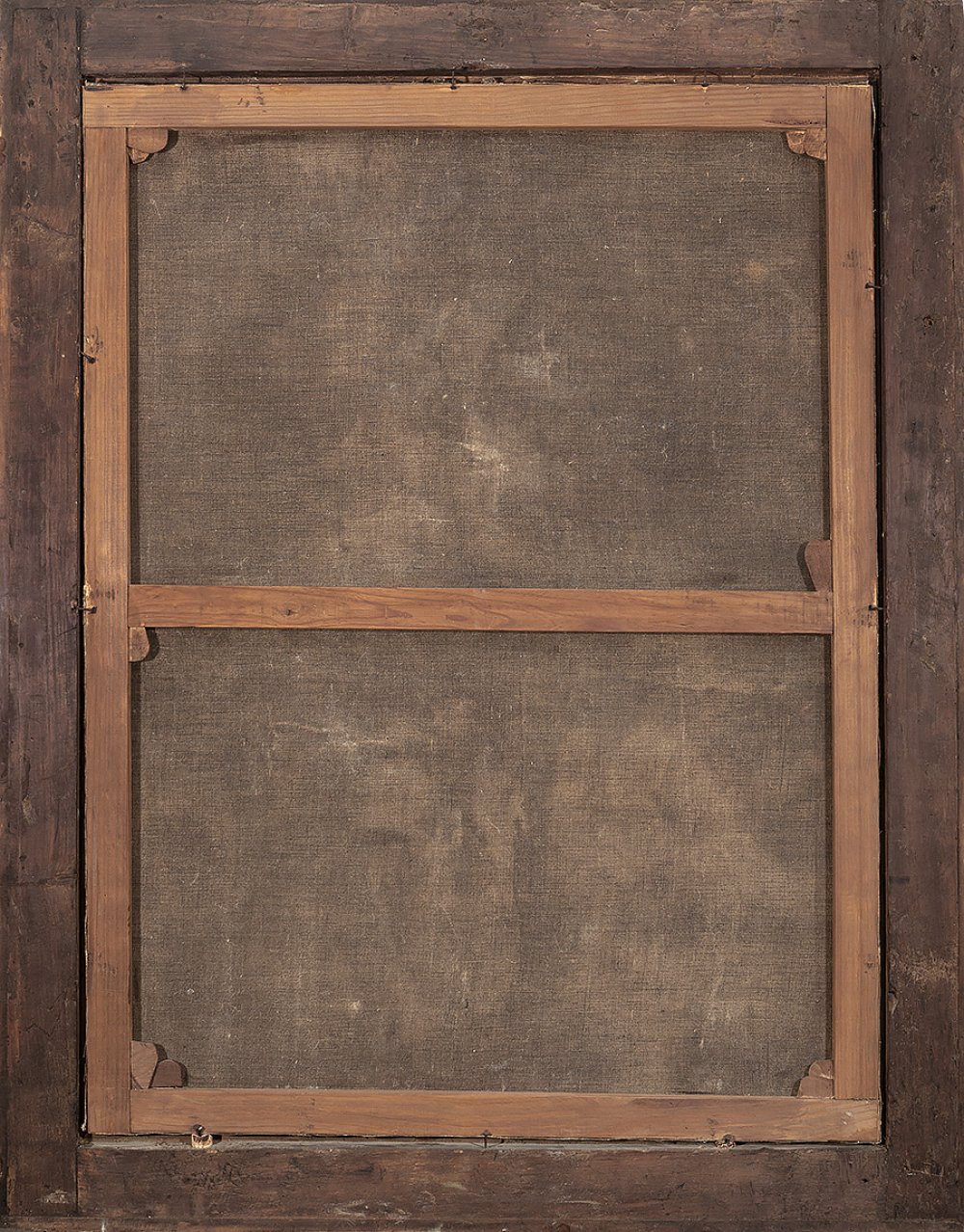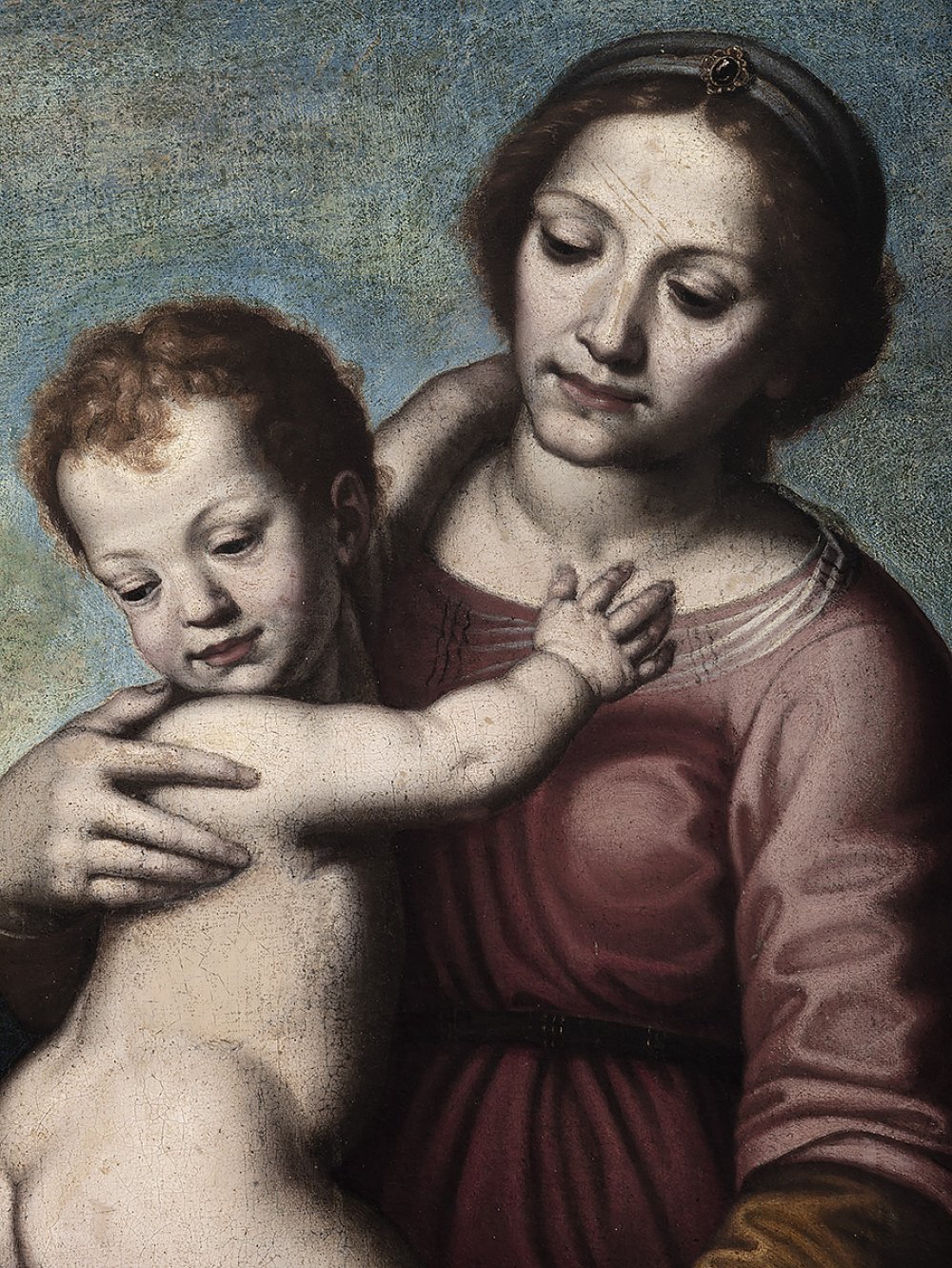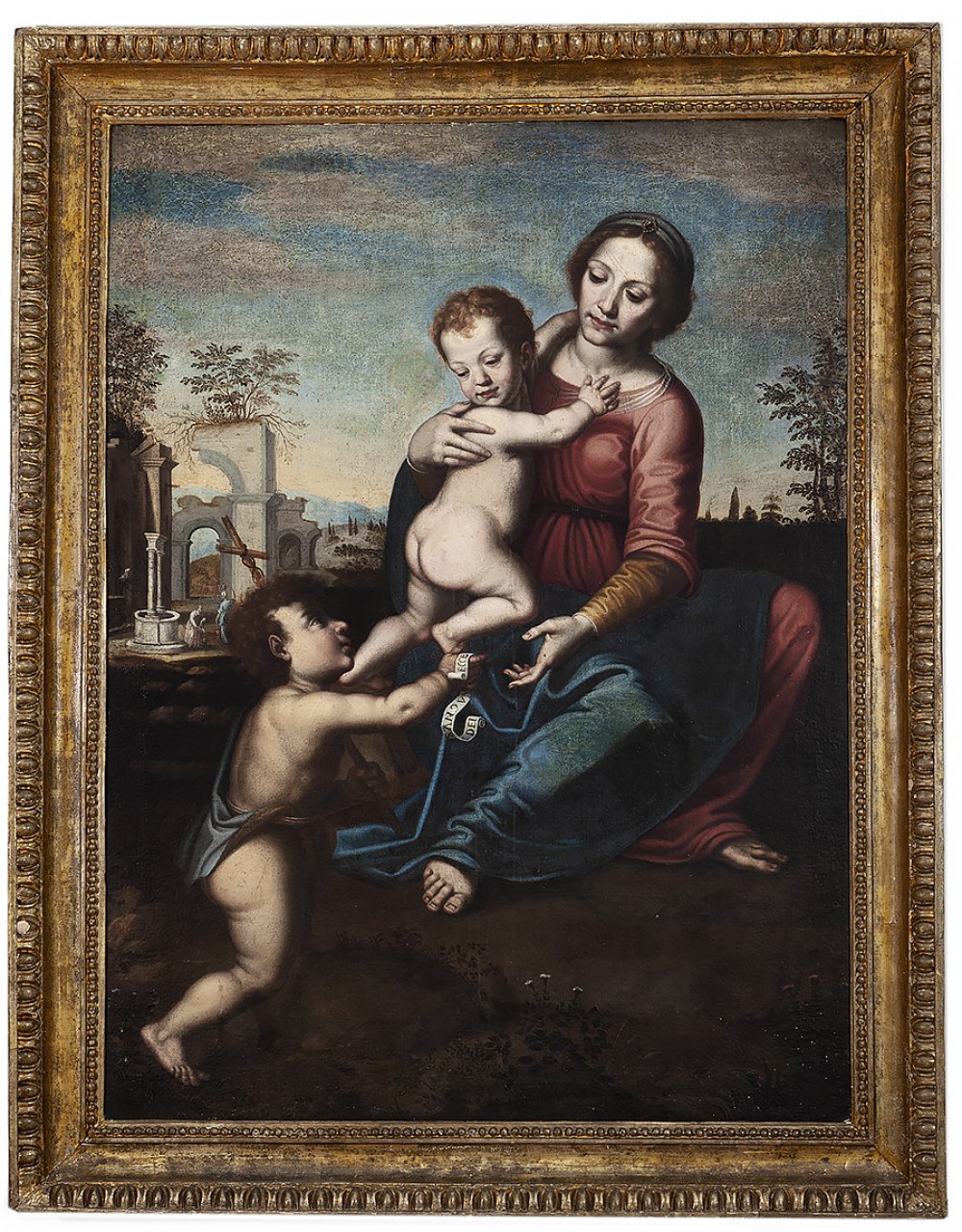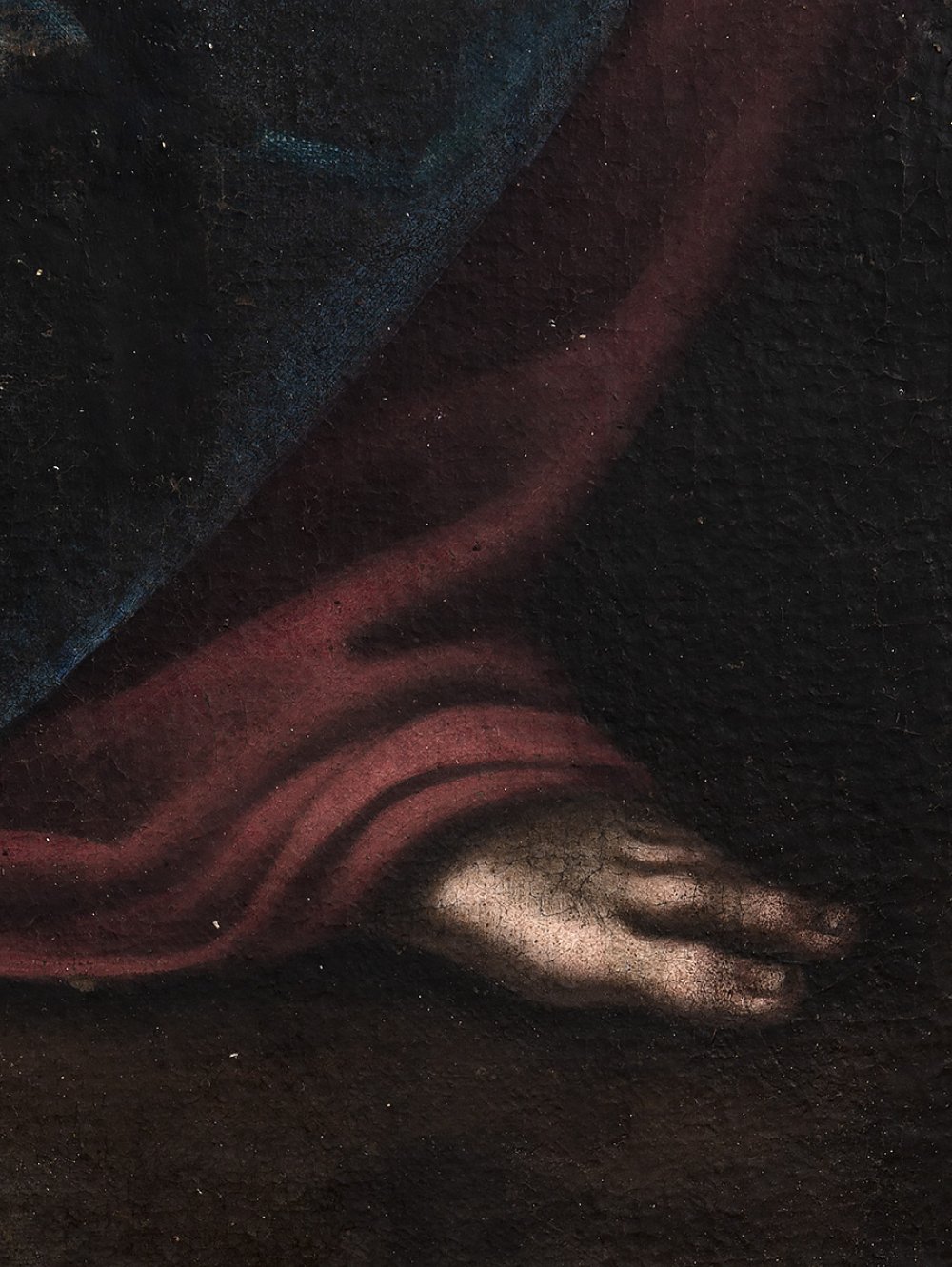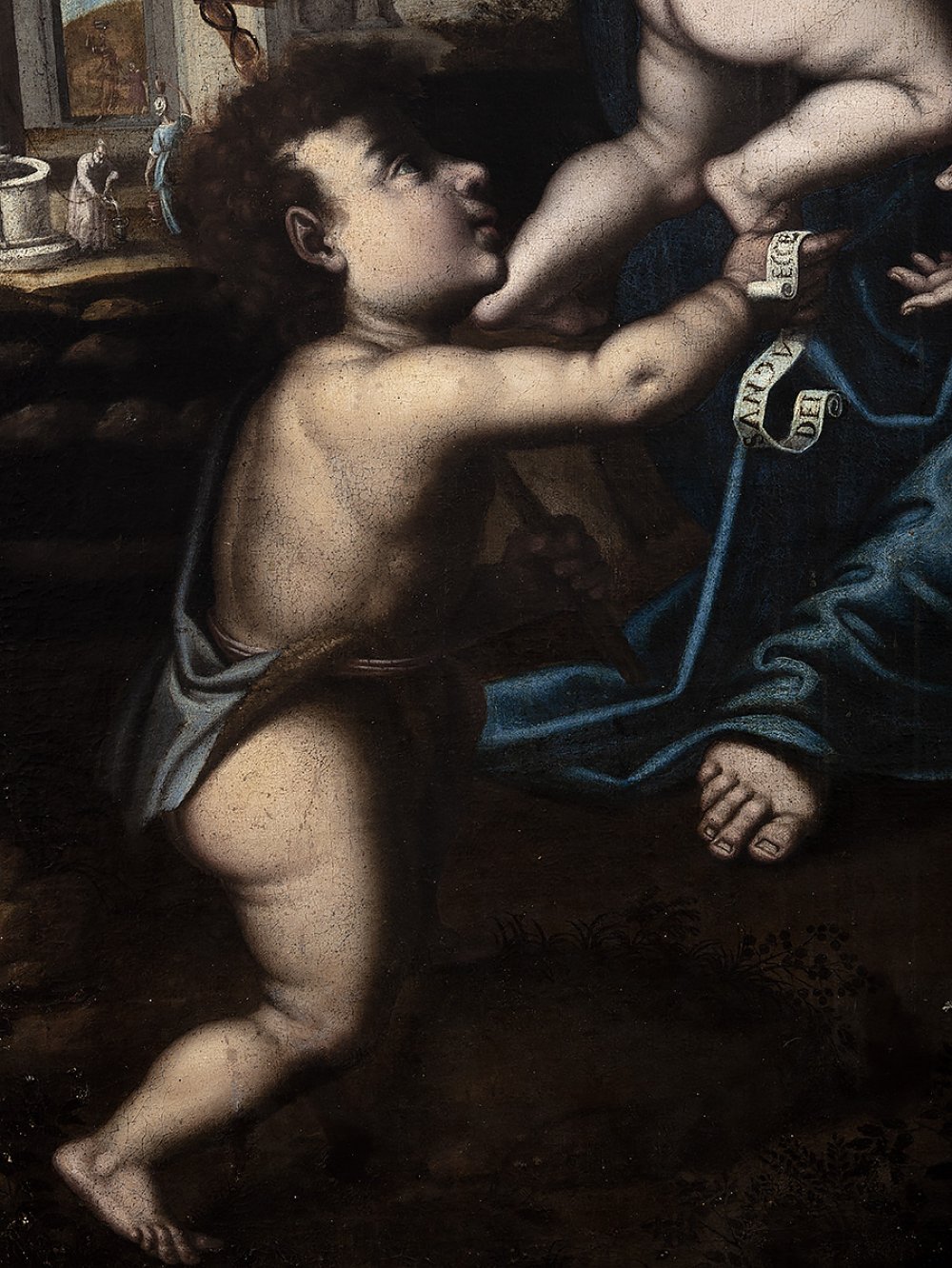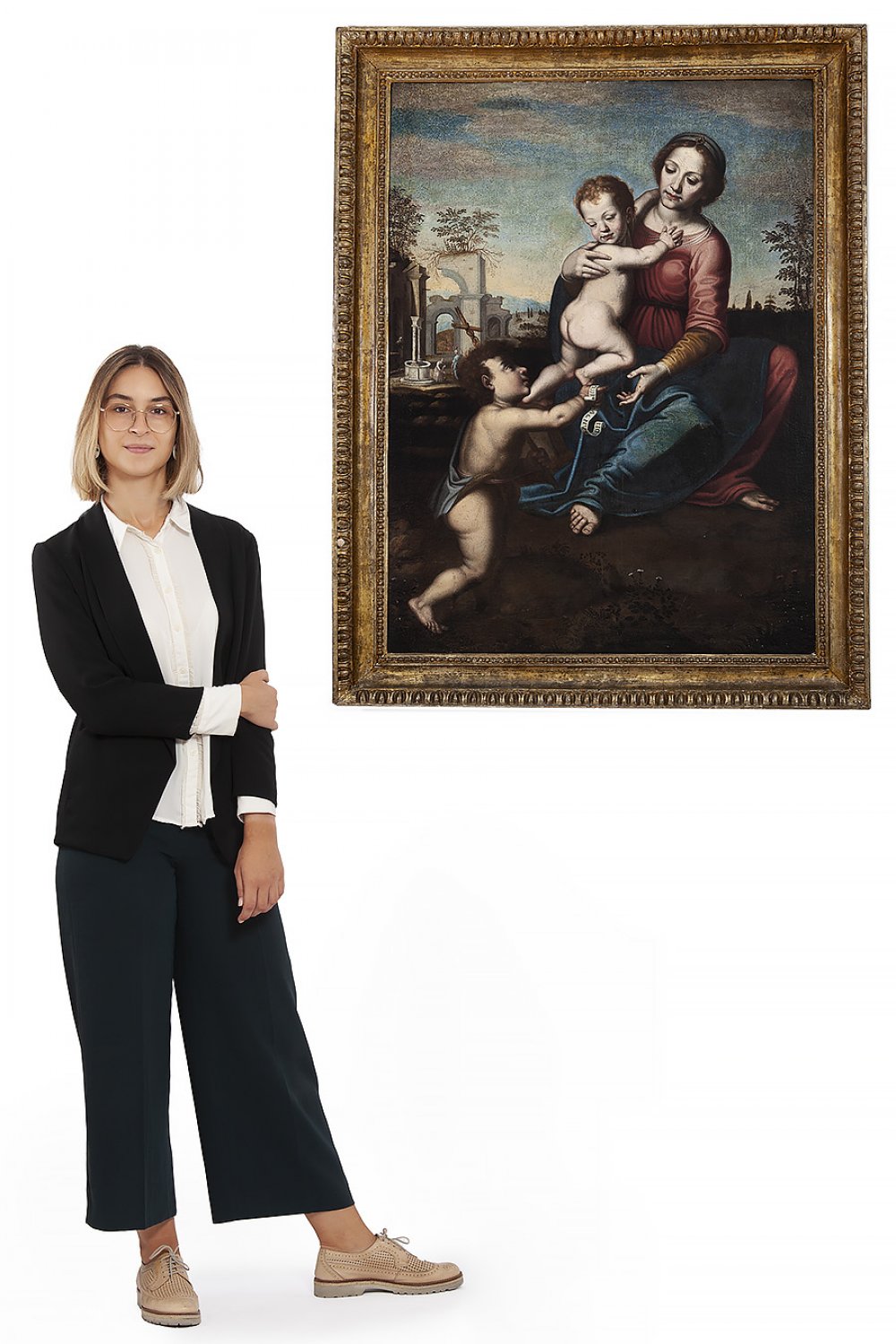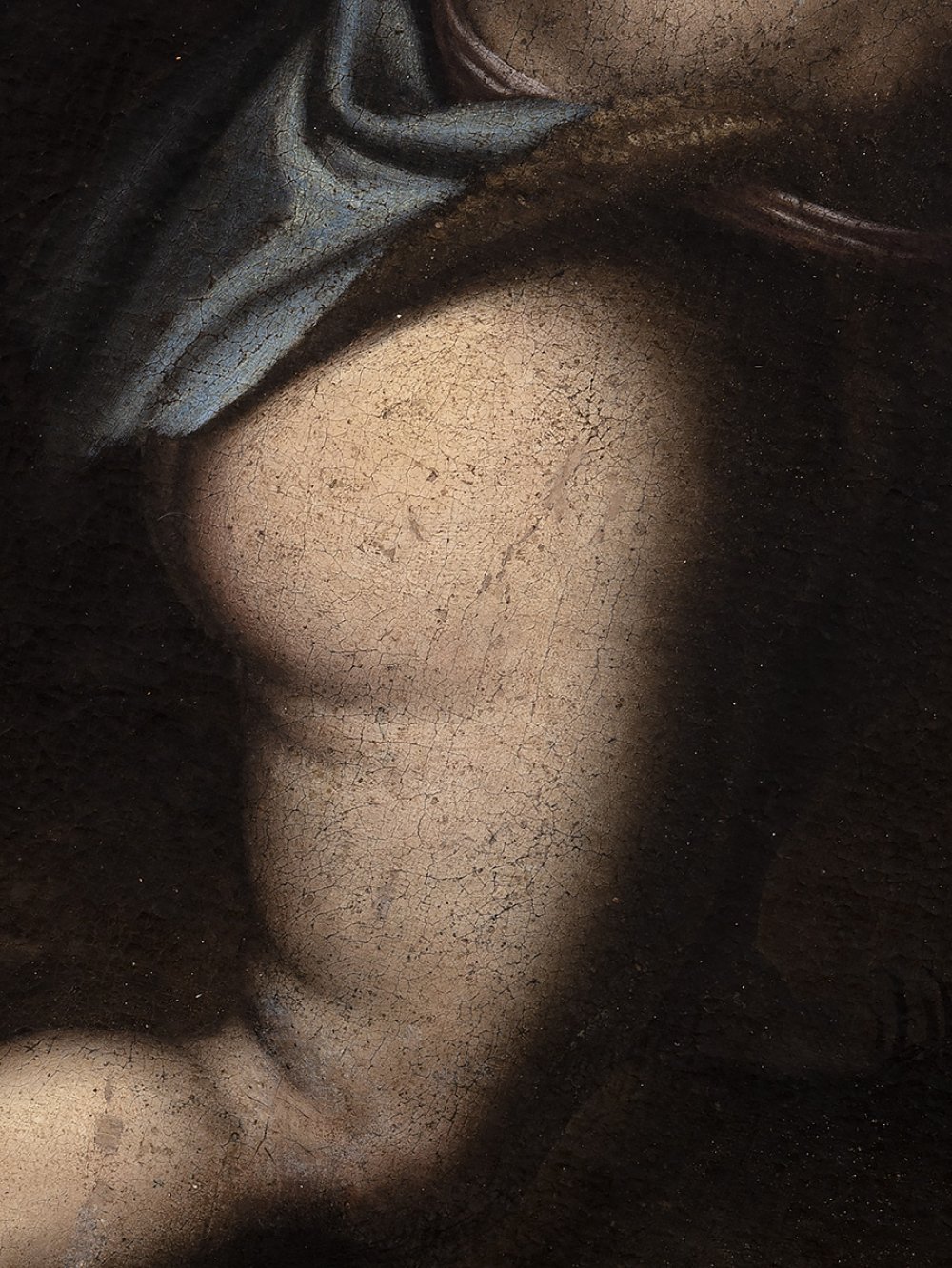24
Italian school of the second half of the 16th century. School of FRANCESCO DI CRISTOFANO, known
"The Virgin of the Well.
Oil on canvas. Re-coloured.
The original work is in the Uffizi Gallery in Florence.
It has a late 18th century frame with wear and tear and restorations.
The canvas has repainting and restorations.
Measurements: 116 x 88 cm, 137 x 106 cm (frame).
In this canvas the author represents a scene very repeated in the History of Art, especially since the Renaissance: the Virgin with the Child Jesus in her arms, accompanied by Saint John, also a child. It emphasises the human aspect of Christ, the innocence and happiness of his childhood, in dramatic contrast to his destiny of sacrifice.
This was a theme that was widely treated in the Renaissance and later Baroque period. Thus, the Saviour and the Baptist are depicted as tender children of delicate beauty and soft anatomy, protected by the maternal figure of Mary, whose face is slightly smiling but whose seriousness shows the knowledge of the bitter fate not only of her son but also of Saint John, who was to be beheaded.
Francesco di Cristofano Bigi or Giudici, better known as Franciabigio, was an Italian painter of the Renaissance. A companion of Andrea del Sarto, he shared his studio with the latter for a number of years. However, he was a much more limited artist than his friend: he was never able to completely rid his style of its Quattrocentista heritage.
He seems to have begun his career as an assistant to Mariotto Albertinelli, from whom he learned the fundamentals of the new style that was then beginning to take hold in Florentine art. He subsequently took Raphael as his principal model, without ignoring the influence of Leonardo da Vinci. In time his style became closely modelled on Sarto's, but in a rather simplistic version.
Around 1511-12 Franciabigio travelled to Rome to study Raphael's recent work. Thanks to this experience he polished his style, achieving a certain nervous expression in his figures that endows them with energy and movement, although without the balance and grace of the painter from Urbino.
In 1514 he undertook one of his most ambitious works, the fresco decoration of the refectory of San Giovanni della Calza. The Florentine government required his services on various occasions as decorator and set designer for various public events.
During Andrea del Sarto's stay in France, Franciabigio took up his post as decorator of the Scalzo cloister (1518-1519). This work contains some of the most ornate figures in Florentine painting at the time.
In October 1504 he was already registered as a painter with the Compagnia di San Luca. In November 1506 he received his first documented commissions for the monastery of San Pancrazio, an institution with which he remained closely linked throughout his life. In 1510 he painted one of his first notable works, a frescoed Adoration of the Shepherds for Francesco Lioni in the chapel of Villa Dani in Montici.
It seems that in 1520 he returned to the Eternal City. On this new trip to Rome he succeeded in integrating into his art something of the classicism that he had admired there. Evidence of this new Romanist impulse can be seen in his vigorous and somewhat rhetorical decorations for the Villa Medicea at Poggio a Caiano, which are among the best of his work. He shared the commission with two of the greatest painters of the time, Andrea del Sarto and Pontormo. The project came to a standstill on the death of the commissioner, Pope Leo X (1521). A few decades later it was enlarged and completed by Alessandro Allori (1582).
In his final years, Franciabigio seems to have forgotten his "Roman" phase and returned to the conservative Florentine tradition. His final works are precious but perhaps lacking the emotion of his finest achievements.
"The Virgin of the Well.
Oil on canvas. Re-coloured.
The original work is in the Uffizi Gallery in Florence.
It has a late 18th century frame with wear and tear and restorations.
The canvas has repainting and restorations.
Measurements: 116 x 88 cm, 137 x 106 cm (frame).
In this canvas the author represents a scene very repeated in the History of Art, especially since the Renaissance: the Virgin with the Child Jesus in her arms, accompanied by Saint John, also a child. It emphasises the human aspect of Christ, the innocence and happiness of his childhood, in dramatic contrast to his destiny of sacrifice.
This was a theme that was widely treated in the Renaissance and later Baroque period. Thus, the Saviour and the Baptist are depicted as tender children of delicate beauty and soft anatomy, protected by the maternal figure of Mary, whose face is slightly smiling but whose seriousness shows the knowledge of the bitter fate not only of her son but also of Saint John, who was to be beheaded.
Francesco di Cristofano Bigi or Giudici, better known as Franciabigio, was an Italian painter of the Renaissance. A companion of Andrea del Sarto, he shared his studio with the latter for a number of years. However, he was a much more limited artist than his friend: he was never able to completely rid his style of its Quattrocentista heritage.
He seems to have begun his career as an assistant to Mariotto Albertinelli, from whom he learned the fundamentals of the new style that was then beginning to take hold in Florentine art. He subsequently took Raphael as his principal model, without ignoring the influence of Leonardo da Vinci. In time his style became closely modelled on Sarto's, but in a rather simplistic version.
Around 1511-12 Franciabigio travelled to Rome to study Raphael's recent work. Thanks to this experience he polished his style, achieving a certain nervous expression in his figures that endows them with energy and movement, although without the balance and grace of the painter from Urbino.
In 1514 he undertook one of his most ambitious works, the fresco decoration of the refectory of San Giovanni della Calza. The Florentine government required his services on various occasions as decorator and set designer for various public events.
During Andrea del Sarto's stay in France, Franciabigio took up his post as decorator of the Scalzo cloister (1518-1519). This work contains some of the most ornate figures in Florentine painting at the time.
In October 1504 he was already registered as a painter with the Compagnia di San Luca. In November 1506 he received his first documented commissions for the monastery of San Pancrazio, an institution with which he remained closely linked throughout his life. In 1510 he painted one of his first notable works, a frescoed Adoration of the Shepherds for Francesco Lioni in the chapel of Villa Dani in Montici.
It seems that in 1520 he returned to the Eternal City. On this new trip to Rome he succeeded in integrating into his art something of the classicism that he had admired there. Evidence of this new Romanist impulse can be seen in his vigorous and somewhat rhetorical decorations for the Villa Medicea at Poggio a Caiano, which are among the best of his work. He shared the commission with two of the greatest painters of the time, Andrea del Sarto and Pontormo. The project came to a standstill on the death of the commissioner, Pope Leo X (1521). A few decades later it was enlarged and completed by Alessandro Allori (1582).
In his final years, Franciabigio seems to have forgotten his "Roman" phase and returned to the conservative Florentine tradition. His final works are precious but perhaps lacking the emotion of his finest achievements.
26th October - Old Masters
Sale Date(s)
Venue Address
General delivery information available from the auctioneer
Setdart offers Worldwide shipping
PICK UP IN ROOM: You can come and pick up your lots in our offices (Barcelona, Madrid or Valencia). At the moment of the withdrawal, you will be able to accept the current conditions of the lot by means of a document that you will sign.
YOU CAN SEND ANOTHER PERSON TO PICK UP: This person must present a signed authorization that you can find in our web page by accessing from BUY AT SETDART- LOGISTICS-DOWNLOAD AUTHORIZATION DOCUMENT. You can also send an e-mail with the requested data in AUTHORIZATION DOCUMENT to admin@setdart.com
Important Information
25% buyer´s premium
21% buyer´s premium at www.setdart.com
Terms & Conditions
The maximum period to pay the lots is 7 working days. You can pay either via bank transfer or with credit card through our platform www.setdart.com (we only accept VISA or Mastercard).
BUYER´S PREMIUM: 22% Hammer price + 21% VAT from the buyer´s premium
If your piece has more than 100 years, our Ministry of Culture requires an export certificate in order for the piece to leave the country. Note that if the piece goes inside the EU, there is no cost for the export certificate. If the piece goes outside the EU, there is a cost for the export certificate. You can find more information in our Ministry of Culture website: https://www.culturaydeporte.gob.es/en/cultura/patrimonio/exportacionimportacion/exportacion/tasas.html
INQUIRIES: admin@setdart.com
Setdart guides you through the entire process, from the time of award to the day you receive your lot. Our logistics team will be happy to manage your transport, and will advise you on the best shipping method with professionals from the sector used to handling works of art and jewelry.
WE OFFER WORLDWIDE DOOR TO DOOR SHIPPING
PICK UP IN ROOM: You can come and pick up your lots in our offices. At the moment of the withdrawal, you will be able to accept the current conditions of the lot by means of a document that you will sign.
YOU CAN SEND ANOTHER PERSON TO PICK UP: This person must present a signed authorization that you can find in our web page by accessing from BUY AT SETDART-LOGISTICS-DOWNLOAD AUTHORIZATION DOCUMENT. You can also send an e-mail with the requested data in AUTHORIZATION DOCUMENT to admin@setdart.com
SETDART IS NOT RESPONSIBLE FOR THE STATE OF THE PARTS ONCE THEY LEAVE OUR FACILITIES. MRW SHIPMENTS: Once the payment is made, your lot will be packed for shipment, the logistics department will send you an e-mail notifying you of the day it leaves our warehouse, changes of address cannot be made after receiving this e-mail.
INSURANCE INCIDENTS: Coverage for the value of the auction up to 3000 ? per shipment, if the value of the auction is higher, Setdart will send you a quote including the additional insurance. The insurance company WILL NOT BE RESPONSIBLE FOR THE SHIPMENT THAT EXCEEDS THAT AMOUNT AND IS NOT FULLY INSURED. MRW INCIDENTS: Maximum notification 48 hours after receipt, after which the insurance company WILL NOT BE RESPONSIBLE AND NO CLAIMS WILL BE ACCEPTED.
E-MAIL LOGISTICS: logistica@setdart.com
PICK UP YOUR MESSAGES: You can send your own messaging, prior notice via e-mail that your shipment is ready, please note 3 or 4 days in advance. This type of shipment is packaged so Setdart will provide you with a quote.
EXPENSES FOR STORAGE: We inform you that if the purchased lot is not picked up within a month, you will be charged 30€ per week per lot. Setdart Online S.L., owner of the web site "setdart.com", "setdart.net" and "setdart.org", acts as a company of Spanish nationality inscribed in the Volume 36955, sheet 182, page B-293056 of the Mercantile Registry, with registered office at Calle Aragó

















